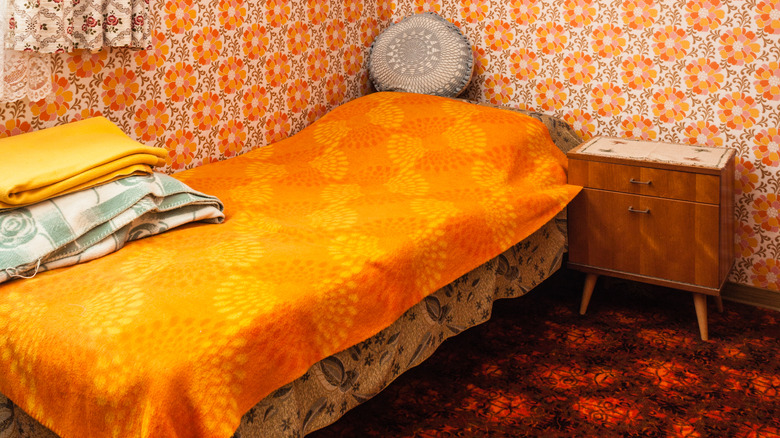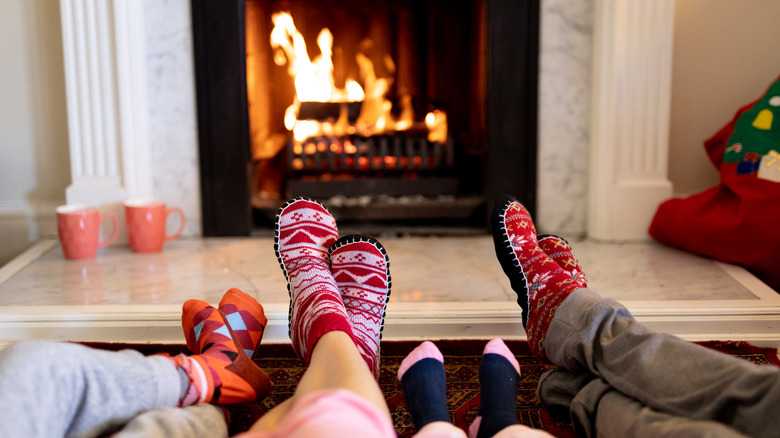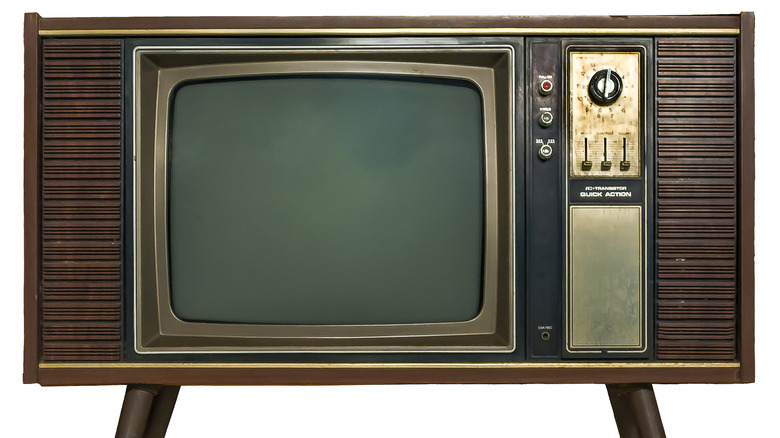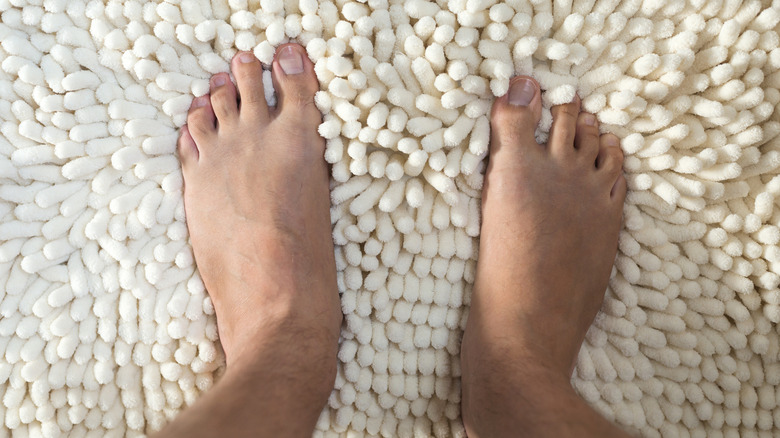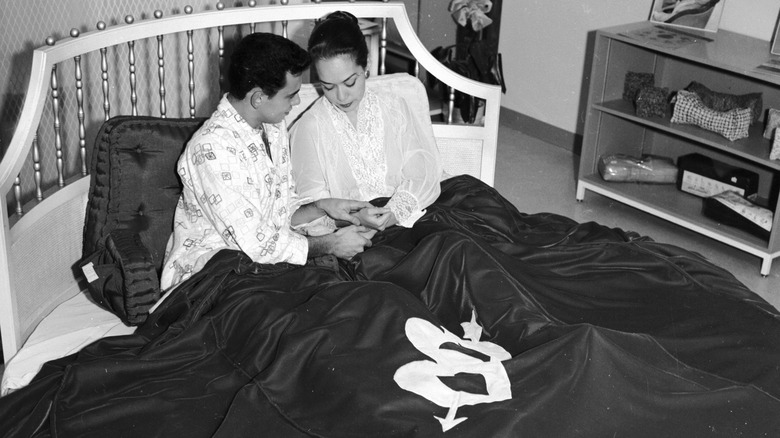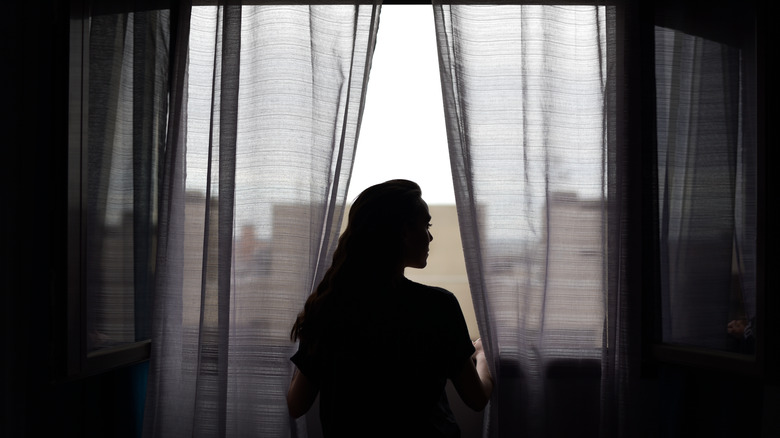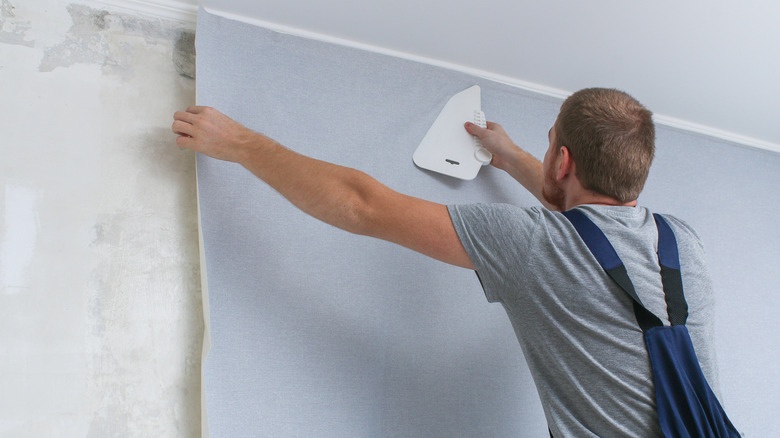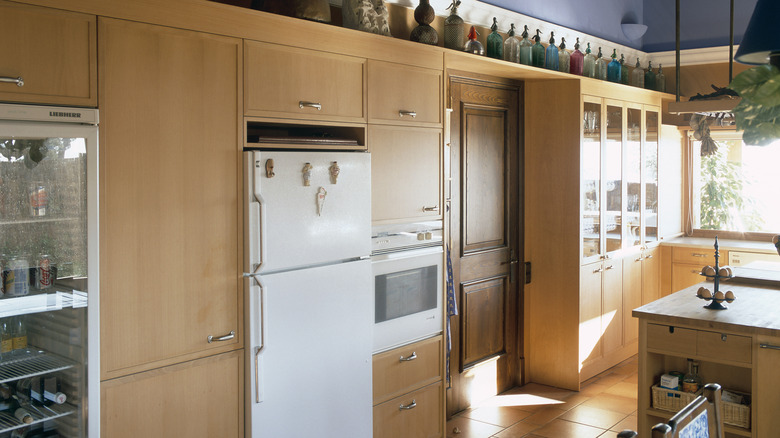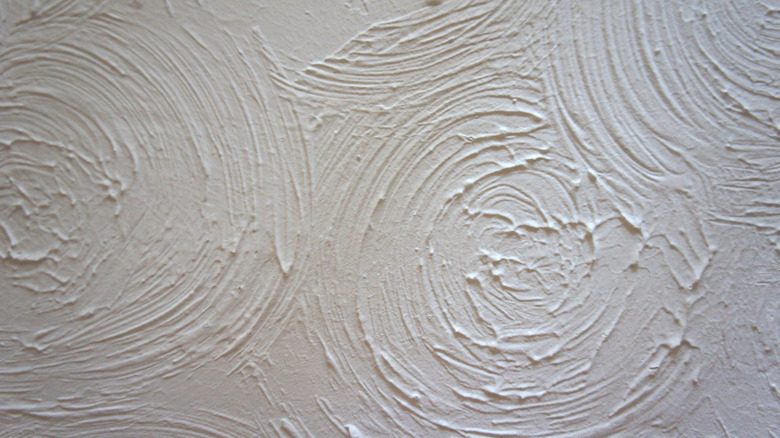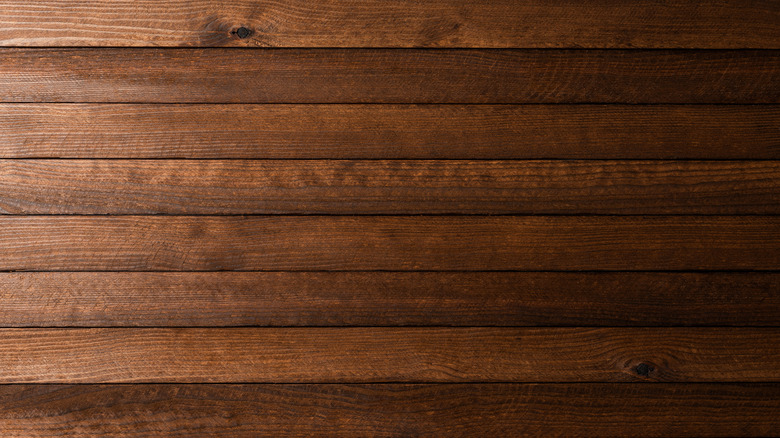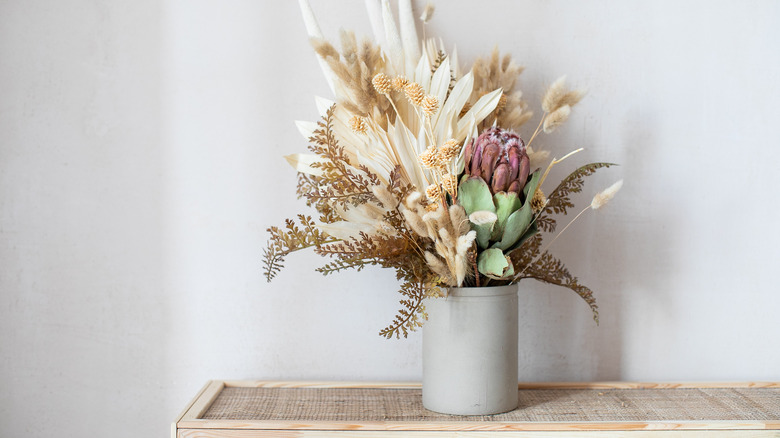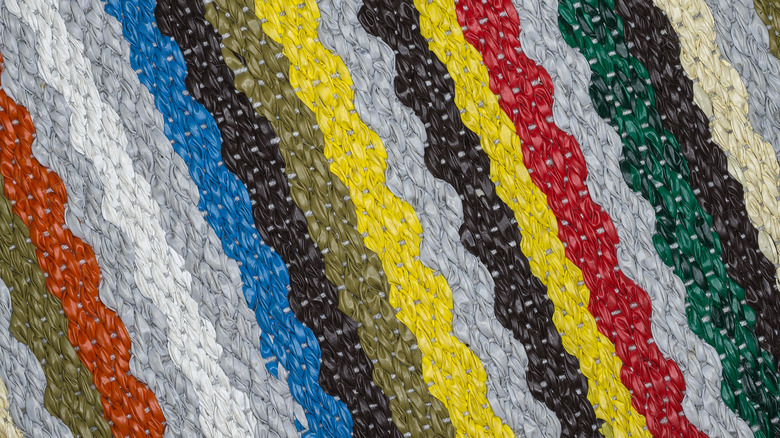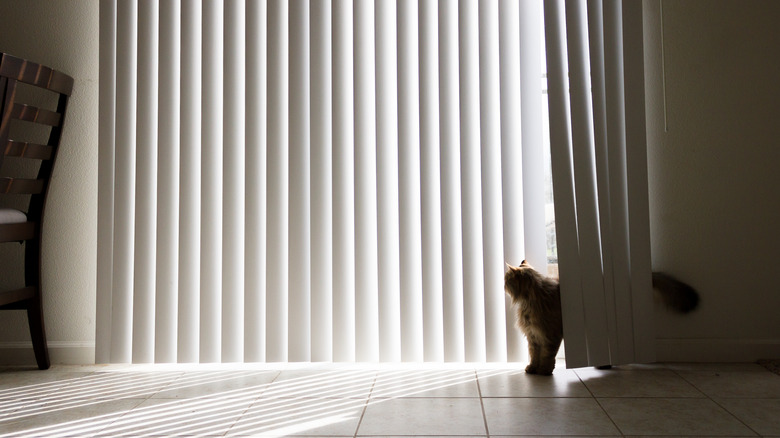Old-School Home Designs That Would Never Fly Today
A house is not just a home — it's also a fashion statement. And as we all know, fashion is a fickle beast. What was hot to trot yesterday may be a rich source of red-cheeked shame tomorrow. Although a select few home design and decor trends are timeless and can withstand the passing of the season and the turning of the tide, as noted by Architectural Digest, most do not. Friends, family, and even the inquisitive delivery guy — who has an irksome habit of outstaying his welcome — all have a habit of judging you on the appearance of your home. Make no mistake, nothing is sacred when it comes to the beady eye of the house guest who will scrutinize every inch of your dwelling to see what decade your decor best represents.
As in all things style is subjective, and although you may feel no pressing need to get some real closure on those outdated chintz curtains or have a compelling urge to ditch the ceiling fan that will never make you cool, it's always wise to have your finger on the pulse when it comes to old school designs that would never fly today. Remember, don't shoot the messenger.
Woodburning fireplaces don't light our fire
There's nothing like the honest toil of chopping up logs for fuel and getting lost in the fancy flame and flicker of an open fire. However, just in case you've been living under a rock and the name Greta Thunberg means nothing to you, there's a climate emergency going on! It may be nice to lounge on your bearskin rug in front of a roaring fire, swigging martinis like James Bond or one of his leading ladies, but fossil fuels burning in an open fire just isn't cool in the modern world. According to The Guardian, when you chuck a log on the fire you're tripling the level of pollution in your home. Doesn't sound so cozy now, does it?
A global review reports that no organ or cell in the human body is immune to air pollution. Additionally, nearly 40% of particle pollution that you breathe in is estimated to be caused by keeping the wood and coal fires burning. As the University of Sheffield's Rohit Chakraborty explained, "Woodburning stoves cause less indoor pollution than open fires but every time you open the door you reduce the stove to an open fire, and particulate matter floods into the home."
So perhaps it's time to get with the program and try rocking a gas fire instead? According to Direct Fireplaces, environmentally-friendly fireplaces have never been hotter. They recommend either gas or electric for homeowners who want a fireplace that looks and feels good.
Thinking outside of the television box
Before TVs became the focal point of any home and we all grew obsessed with their size, smartness, and definition, they were regarded as guilty secrets and ugly pieces of furniture to be hidden away in great big ugly wooden boxes. According to MeTV, the bulky cathode ray tubes of antiquity needed to be enclosed in some serious and ornate cabinets, perched on elaborate bracket feet. Many cabinets came with such enticing and intricate craftsmanship as false drawer knobs and faux keyholes. Although big, polished, and dark wood boxes might have appeared quite fetching in Victorian England, they simply won't wash in the sleek, sharp, and minimalist smart homes of the digital age.
Televisions today aren't designed to compliment anything because their intimidating screens and plastic and glass dynamic are designed as stand-alone centerpieces. If you're still one of the select few who wishes to hide their TV away, there are a few funkier alternatives to a wooden box. House Beautiful has described modern televisions as "gaping black holes” that threaten to engulf our entire homes. It seems a bit harsh, but if you really want to hide your TV, don't put it in a box — try disguising it on a gallery wall, hide it behind a sliding panel, or get a picture TV. That way when you're done bingeing on Netflix, you can flick a switch and voila! You'll have a gallery of tasteful landscapes and watercolors on display.
Carpets in the bathroom were a mistake
It's important to be comfortable when you're conducting affairs of a personal nature on your porcelain throne, but by all the gods of ancient Rome, what insanity besieged the human race to ever think carpets in the bathroom were a grand idea? According to Soakology, a carpet in the bathroom may feel warm and cozy to the feet, but it would probably turn your stomach faster than a plate of rotting pork if you could see the millions of bacterial nasties that could be hiding in the fluff and fleck of a well-designed weave. All that splash and spill from the toilet bowl will be readily absorbed by a greedy carpet and repeatedly deep cleaning it will not only wear you out, but it'll also leave you financially flushed.
When carpets meet the heat and humidity of a bathroom it's a perfect recipe for moisture. And what does moisture attract? You got it: mold and mildew. Before you can even scream "toxic spores," the combined might of mold and bacteria interacting in your carpet will leave your bathroom smelling like a fishing boat just returning to port after a three-week bonanza. Carpets in the bathroom get smelly and stained, and are simply not pretty. They may have once been a sign of status (via Home Stratosphere), but we're not living in the 1970s anymore, so live a little and invest in some wooden or tiled flooring when it comes to the privy!
Bed designs that'll give you nightmares
In the 1980s people did a lot of crazy things: They got excited about faxing, memorized phone numbers, developed a fetish for neon spandex, and thought wearing more than one watch at the same time was the height of fashion. People also thought round beds and water beds were a good idea. According to Home Stratosphere, round beds made their first appearance in the swinging '60s, but they really hit their stride in the "greed decade," when the likes of Hugh Hefner extolled the virtues of the circular bed from his Playboy mansion. Hefner's bed also rotated, had an in-built stereo, and had a wet bar — yet did it provide him with a good night's rest one wonders?
In both TV and film, round beds would come to be associated with a must-have accessory for any self-respecting 1980s villain — think Sam Bouchard in Brian De Palma's "Body Double" (per Architectural Digest). As the standard accessory of a particular type of playful bachelor, the market for round beds persisted well into the 1990s. Thankfully, along with the equally dire vogue for water beds which has since dried up, those days are gone, and in the past, they must remain. It's time to heal, come together, and say "never again!"
Say no to net curtains and doilies
Net curtains may bestow you with a certain sense of privacy, but they can also make you look like a nosy neighbor who loves a bit of "I spy" and curtain-twitching. Besides, they're terminally frumpy and old-fashioned. According to Hillarys, you don't have to feel trapped in a net you cannot escape — there are alternatives. Voile curtains, for example, are all-singing and all-dancing net curtains for the modern age. The fancy frills and lacy swags have been ditched but the opaque and barely-there fabric affords you the same privacy of net curtains. This means you can continue to paint yourself blue and dance like no one's watching to your heart's content.
In whatever dark and dreary corners of the home decor landscape you find net curtains, you'll usually find the dreaded lace doilies. Once again, these products of a bygone age — when stiffly attired ladies and gentlemen used to take afternoon tea and discuss matters relating to "empire" — are a non-starter for today's bright, light, and modernist homes. According to From Times Past, the original purpose of lace doilies was to protect the back of chairs from the Macassar oil Victorian men used to cover their hair with. When oil-slicked hairstyles fell out of favor, the dollies remained. In a bid to show their worth as wives and mothers, women were encouraged to show off their needle skills by creating decorative doilies. Let us speak no more on this subject.
Wallpaper borders are yesterday's fad
In any field, there's a border that no sane soul should cross. In the world of interior design, that border is wallpaper borders. In the 1980s and 1990s, wallpaper borders were in vogue, but times and tastes change; although wallpaper borders were once considered a tasteful and nuanced way to break up a bit of empty wall space, they are now recognized for what they are: a crime against humanity! According to SF Gate, although wallpaper is not considered old hat, wallpaper borders are very much yesterday's fad. It may be because this choice of decor was inflexible, generic, looked cheap, and lacked personality, or there may well be a universal law that dictates that thou shall not use wallpaper borders.
For the no-nonsense and uncompromising brigade, nothing beats wall-to-wall wallpaper to banish the memories of paper borders. However, if you've got something of a creative itch there is a range of options to complement and contrast your personalized wallpaper. A painted or stenciled border can funk up your wall quicker than James Brown at the Apollo, and thanks to technology, vinyl decals can jazz up your wall space with some customized artwork. Any way you slice it, we're on the border of a new age in wallpapering and it's time to think big.
Over-the-top kitchen cabinets are over
Huge, intimidating, and towering kitchen cabinets made out of wood can make any sized kitchen feel claustrophobic. Not only do they take up a ridiculous amount of space, but they are also magnets for a huge amount of hoarded clutter. Yet once upon a time, we paid scant regard to the head-space in a room where fresh air and hygiene are of the essence. According to Architectural Digest, designers have declared war on the traditionalists when it comes to kitchens. A place to store your glass and plates must now play second fiddle to the ideal of a kitchen that is open, airy, and at eye level. For hardcore Marie Kondo enthusiasts, the thought of ripping out cabinet after cabinet as you declutter and purge may be bliss incarnate, but for those of you who are reluctant to part with Aunty Sue's Tupperware and Granny Ethel's egg-timer, you may well wonder where a soul can store their overflow with all the cabinet space reduced to a minimum.
Fear not! As a species, we are extremely innovative at finding new and ingenious ways to hoard things we just don't need. Consider a freestanding shelf unit, a plate rack, or even a tastefully decorated storage box that doubles up as a bench. Once your cabinets are replaced with towering tiled walls to give your kitchen a bright, light, and glimmering feel, the sacrifice will be worth it, and you can enjoy your microwave-ready meal in peace.
Awful artex ceilings can actually be dangerous
Artex ceilings are sometimes called "popcorn" or "cottage cheese" ceilings. Although the name may change, the pain these monstrosities inflict upon our eyes remains the same. These ornate plaster ceilings were ugly then and they're ugly now. We have even gone as far as to ask: Is there anything more universally loathed than a popcorn ceiling? That's how hated this particular brand of decor that really took off in the 1970s is. Popcorn ceilings were favored by builders and DIY enthusiasts because they were financially viable, covered up imperfections, were an effective means of sound insulation, and rendered the need to paint ceilings obsolete. Yet all that cost-cutting and step-skipping came at a price! The worst thing about artex ceilings is that early artex used to contain asbestos (via Inner City Environmental).
Asbestos is now banned in all building products and it's important to stress that not all surviving artex will contain asbestos. Yet if it's from the '60s, '70s and '80s, chances are it contains anywhere between 1% to 4% of asbestos. As long as the artex remains undamaged, the asbestos is not a risk to your health as the fibers cannot be released and breathed into your lungs. The only way to know for sure if an artex ceiling contains asbestos is to get it professionally tested. There's no way a home decor trend that was this ugly, and a potential risk to your health would ever fly in today's world.
Wall-to-wall wood went way out
The same instinct which drives lemmings to leap off cliffs may not be the same instinct that once motivated hordes of people in the 1970s to cover their house from top to bottom with wall-to-wall wood paneling, but they definitely share the same ballpark. Living in a forest of dead wood is an acquired taste but thankfully, not one shared by the modern palette. According to Networx, properties that still carry the stigma of wood paneling should not be forsaken out of hand, and there are relatively easy steps you can follow to make this great wrong right!
If your finances cannot stretch for a complete refurb, why not grab a couple of tins of paint and get busy covering all that brown wood with some funky shades of the rainbow? Painted wood may sound horrific, but you'll be surprised how groovy it can make your paneling if you channel your inner Picasso and apply a little TLC. Additionally, if your wood paneling leaves you distressed, then why not turn the tables and get busy distressing the wood? Rustic and organic timber is hip, happening, and hot, and if you find the right decorator you'll be surprised what they can achieve. If all else fails, build a faux wall over the paneling with a carefully applied combination of wallpaper and paint, paint, and paint some more until the wooden nightmare lays buried and forgotten beneath layers of a vibrant emulsion.
Dead flowers may invite bad vibes
Dried, or to put it bluntly, dead flowers were once all the rage in the homes of people of all persuasions, but thankfully we've turned a corner and realized if you can't spruce up your home with a few artfully picked Lilies, you need to try harder. According to Elle Decor, dead flowers not only look horrendous, but they're also bad for your home's feng shui! Apparently, when they dry up and lose their moisture, flowers also lose their positive chi. As chi is the feng shui energy that flows through everything, particularly the design and layout of your home, this is bad news. The negative chi of dead flowers can detrimentally affect your health and well-being by sucking up your home's vitality and vibrancy. That is, of course, if you believe it?
Yet House Beautiful reports that according to feng shui consultant Rodika Tchi, you can counter the vibrational damage caused by dried flowers if you ensure the energy is special. "Ask your heart what it is thinking about your dried flowers," she wrote. "If you feel beautiful, healing energy connected to them, then, of course, keep them." Either way, dead flowers and Potpourri may be low maintenance, but they're not a good look in an age where keeping it real and getting back to nature is all the rage. You can't beat a few carefully plucked roses if you want to make a blooming statement.
Migraine-inflicting carpets are all rolled up
Before we grew to collectively loathe carpets as bacteria-infested filthy floor coverings, and all converted en masse to the church of laminate flooring and hardwood floors, we not only filled our homes with carpets — we also tried to make them look funky with some migraine-inflicting designs. There was also this thing called shag carpeting it's best not to talk about anymore. As we continue our recovery and take tentative steps on our journey back to sanity we can now look at these carpets of yesteryear and laugh, albeit if a little hysterically. According to Apartment Therapy, one of home improvement's 10 commandments should be, "Thou shall remove every fiber of carpet from thy home." Strong words, but it's a strong subject.
Carpets were once the sole prerogative of the wealthy who considered them luxurious. As the trend spread like a virus, a home wasn't considered a home without a carpet and the designs just got more elaborate until we awoke from our mass malady, rolled up the carpets, and said "no more!" Interestingly, in Las Vegas they purposefully make the carpets in their casinos as hideous as possible to make people gamble more. Wired reports that Dave Schwartz, Director of the Center for Gaming Research at Nevada University, explained, "Casino carpet is known as an exercise in deliberate bad taste that somehow encourages people to gamble." Go figure!
Vertical blinds that'll bring you down
When Edward and Frederick Bopp invented vertical blinds back in 1950 (via TLC Interiors), they unleashed an interior design horror on the world that is still causing untold misery to this day. Their corporate and industrial look can turn any home into a doctor's waiting room, and stylist Chris Carroll has gone as far to call them, "the devil's work." As he explained, "It's not just the look of vertical blinds that I loathe. Yes, they remind me of corporate offices of the '90s. But looks aside I hate the way they function too. I hate seeing those tassels at the bottom, connecting each vertical panel. There is nothing worse than friends or family coming over to your home and having to put them through looking at your vertical blinds. What horror."
According to At Well Staged Home, HGTV's Donna Freeman is a fellow enthusiast in the campaign of hate directed toward this outdated home decor trend, and once snarled, "If I were a president I would outlaw vertical blinds." Would you vote for her? Millions would, because it appears that vertical blinds have had their day and that day was dire. It's time to throw open the curtains on a brave, new dawn and no longer be blinded by the blinds of times long gone.
